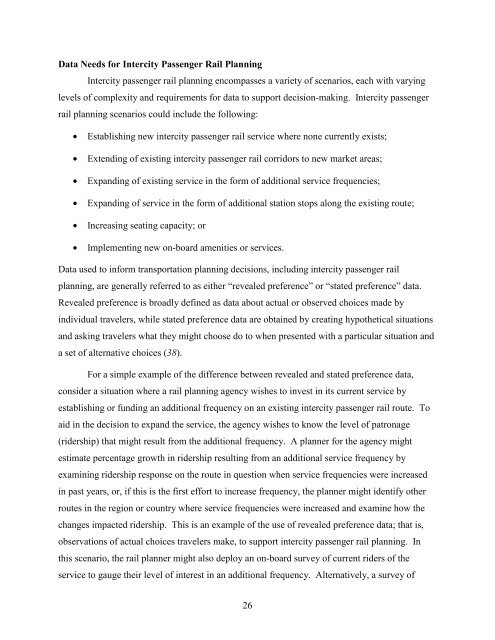Measuring the Benefits of Intercity Passenger Rail: A Study
Measuring the Benefits of Intercity Passenger Rail: A Study
Measuring the Benefits of Intercity Passenger Rail: A Study
You also want an ePaper? Increase the reach of your titles
YUMPU automatically turns print PDFs into web optimized ePapers that Google loves.
Data Needs for <strong>Intercity</strong> <strong>Passenger</strong> <strong>Rail</strong> Planning<br />
<strong>Intercity</strong> passenger rail planning encompasses a variety <strong>of</strong> scenarios, each with varying<br />
levels <strong>of</strong> complexity and requirements for data to support decision-making. <strong>Intercity</strong> passenger<br />
rail planning scenarios could include <strong>the</strong> following:<br />
• Establishing new intercity passenger rail service where none currently exists;<br />
• Extending <strong>of</strong> existing intercity passenger rail corridors to new market areas;<br />
• Expanding <strong>of</strong> existing service in <strong>the</strong> form <strong>of</strong> additional service frequencies;<br />
• Expanding <strong>of</strong> service in <strong>the</strong> form <strong>of</strong> additional station stops along <strong>the</strong> existing route;<br />
• Increasing seating capacity; or<br />
• Implementing new on-board amenities or services.<br />
Data used to inform transportation planning decisions, including intercity passenger rail<br />
planning, are generally referred to as ei<strong>the</strong>r “revealed preference” or “stated preference” data.<br />
Revealed preference is broadly defined as data about actual or observed choices made by<br />
individual travelers, while stated preference data are obtained by creating hypo<strong>the</strong>tical situations<br />
and asking travelers what <strong>the</strong>y might choose do to when presented with a particular situation and<br />
a set <strong>of</strong> alternative choices (38).<br />
For a simple example <strong>of</strong> <strong>the</strong> difference between revealed and stated preference data,<br />
consider a situation where a rail planning agency wishes to invest in its current service by<br />
establishing or funding an additional frequency on an existing intercity passenger rail route. To<br />
aid in <strong>the</strong> decision to expand <strong>the</strong> service, <strong>the</strong> agency wishes to know <strong>the</strong> level <strong>of</strong> patronage<br />
(ridership) that might result from <strong>the</strong> additional frequency. A planner for <strong>the</strong> agency might<br />
estimate percentage growth in ridership resulting from an additional service frequency by<br />
examining ridership response on <strong>the</strong> route in question when service frequencies were increased<br />
in past years, or, if this is <strong>the</strong> first effort to increase frequency, <strong>the</strong> planner might identify o<strong>the</strong>r<br />
routes in <strong>the</strong> region or country where service frequencies were increased and examine how <strong>the</strong><br />
changes impacted ridership. This is an example <strong>of</strong> <strong>the</strong> use <strong>of</strong> revealed preference data; that is,<br />
observations <strong>of</strong> actual choices travelers make, to support intercity passenger rail planning. In<br />
this scenario, <strong>the</strong> rail planner might also deploy an on-board survey <strong>of</strong> current riders <strong>of</strong> <strong>the</strong><br />
service to gauge <strong>the</strong>ir level <strong>of</strong> interest in an additional frequency. Alternatively, a survey <strong>of</strong><br />
26
















